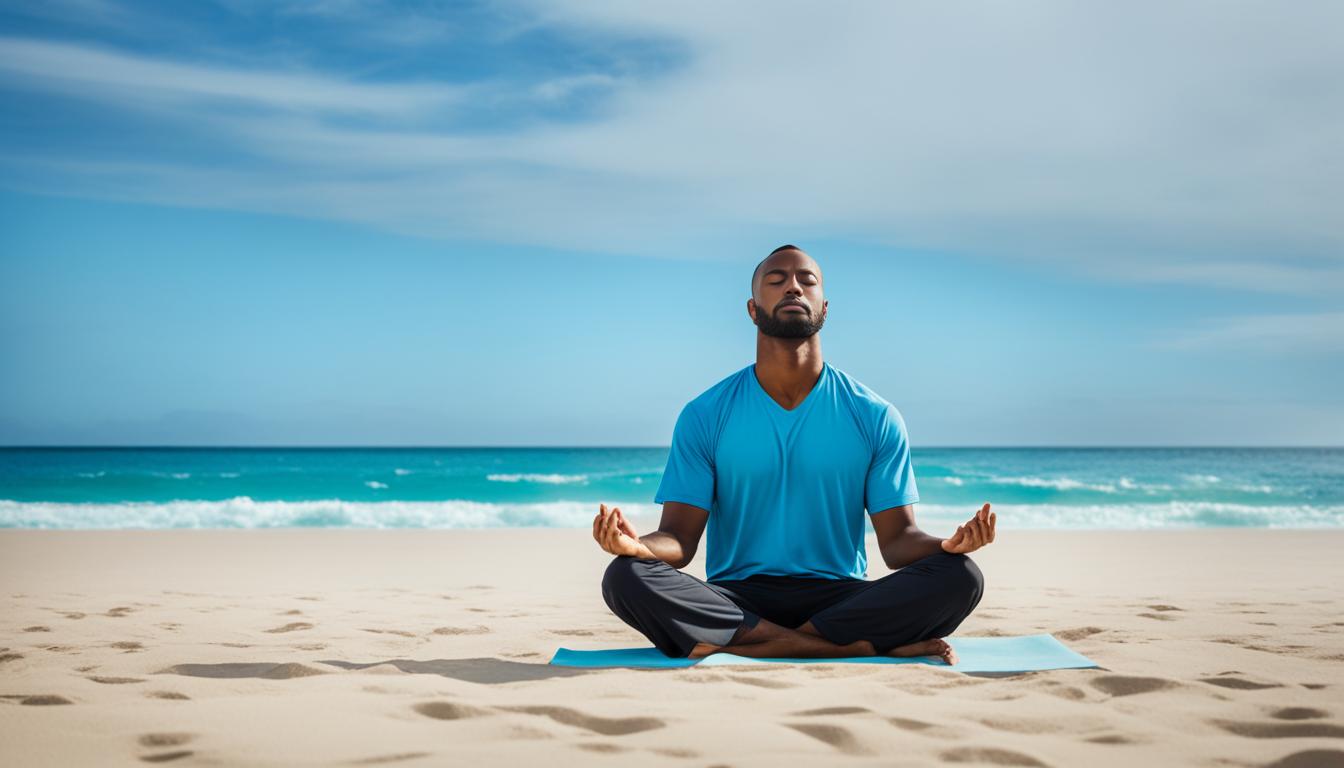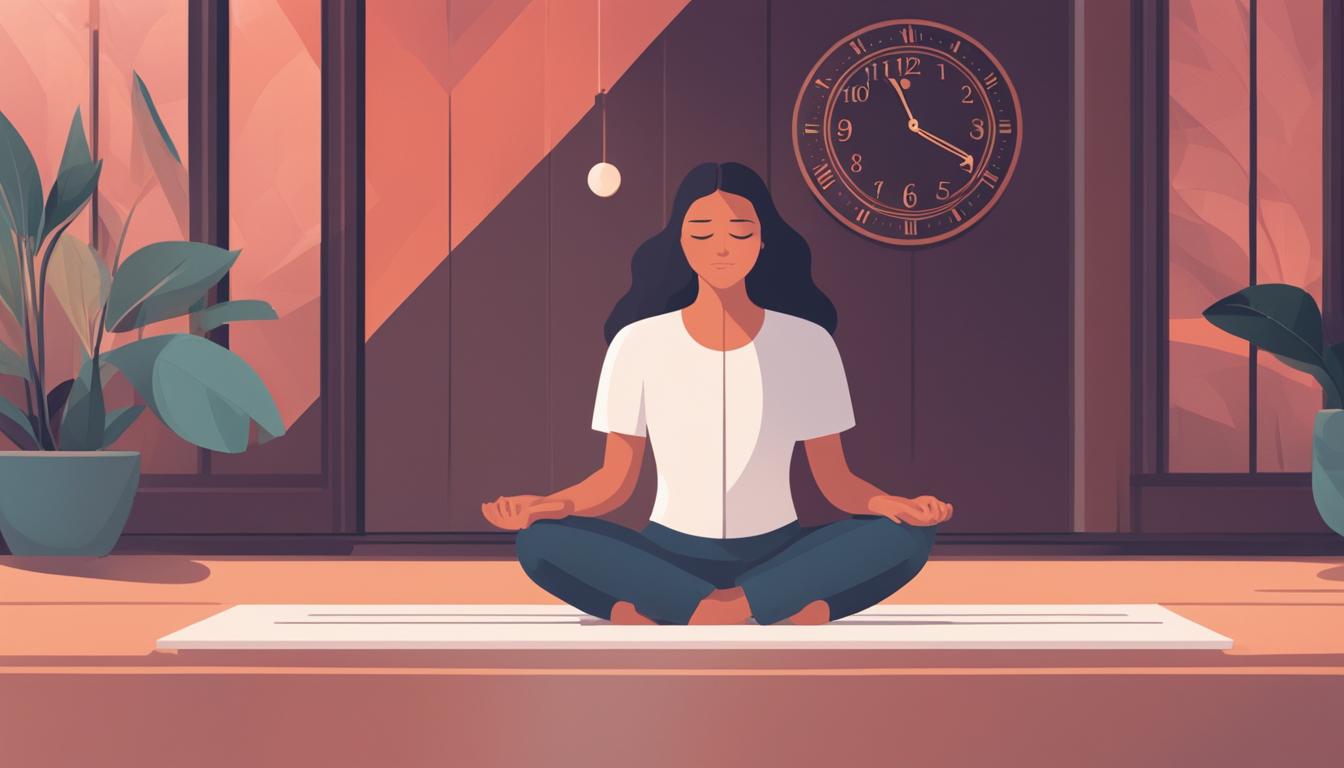Welcome to our quick 3-minute meditation guide! In today’s fast-paced world, finding moments of calm and relaxation can be challenging. But with a short and simple meditation practice, you can bring instant calm and reduce stress in just a few minutes each day. In this guide, we will explore easy meditation techniques that will help you experience the benefits of mindfulness in 3 minutes.
Key Takeaways:
- Practice a 3-minute meditation for instant calm and stress relief
- Incorporate mindfulness into your daily routine
- Overcome challenges such as distractions and racing thoughts
- Adapt your meditation practice to different settings and situations
- Explore different types of 3-minute meditations to find what resonates with you
The Benefits of 3 Minute Meditation
Research has shown that even just a few minutes of meditation each day can have a significant impact on your mental health and well-being. By dedicating a few minutes each day to a 3 minute meditation practice, you can experience a range of benefits that promote relaxation, stress relief, and emotional well-being.
Meditation is a powerful tool for reducing stress, improving focus and clarity, and promoting a sense of calm in your daily life. When you take time to quiet your mind and focus on your breath or a specific focal point, you allow yourself to relax and let go of the tension and worries that accumulate throughout the day. This can help you feel more centered and present, leading to increased mental clarity and enhanced productivity.
When you practice a 3 minute meditation regularly, you cultivate a deeper connection with yourself and your emotions. By observing your thoughts and feelings without judgment, you can develop a greater sense of self-awareness and emotional well-being. This increased self-awareness can empower you to manage stress more effectively and make mindful choices that support your overall mental health.
Furthermore, a 3 minute meditation practice can have a positive impact on your physical health as well. As you relax your mind, you may notice a corresponding relaxation of tension in your body. This can help alleviate physical symptoms of stress, such as headaches or muscle tightness, and contribute to an overall sense of well-being.

“In as little as three minutes, meditation reduces stress, improves focus, and promotes emotional well-being. It’s a simple practice with profound benefits.”
By incorporating a 3 minute meditation practice into your daily routine, you are prioritizing your mental and emotional well-being. Whether you choose to meditate in the morning to start your day on a calm note or in the evening to unwind and relax, these few minutes of mindfulness can make a significant difference in your overall quality of life.
So, take a deep breath, close your eyes, and dedicate just three minutes each day to meditation. Experience the power of this simple practice in reducing stress, enhancing focus and clarity, and fostering emotional well-being. Start your journey towards a calmer and more balanced life today.
How to Practice a 3 Minute Meditation
Practicing a 3-minute meditation can be simple and accessible for anyone, regardless of their experience level. Start by finding a quiet and comfortable space where you won’t be disturbed. Take a moment to set the intention to find calm and relaxation.
Begin by focusing on your breath, allowing yourself to become fully present in the moment. Take deep, slow breaths in and out, feeling the sensation of the breath entering and leaving your body. Let go of any tension or stress as you exhale.
If you prefer a more guided approach, you can try a body scan meditation. Bring your awareness to each part of your body, starting from your toes and moving up to your head. Notice any sensations or areas of tension, and as you breathe, imagine sending your breath to those areas to release the tension and promote relaxation. Feel your entire body becoming more and more relaxed with each breath.
Another option is to follow a guided meditation that walks you through the practice step by step. There are many apps and websites available that offer guided meditations for various lengths of time, including 3 minutes. Allow the soothing voice of the guide to lead you into a state of calm and mindfulness.
Experiment with different techniques to find what works best for you. Whether it’s focusing on your breath, doing a body scan, or following a guided meditation, the key is to find a method that resonates with you and helps you achieve a state of mindfulness and relaxation.

Incorporating 3 Minute Meditation into Your Daily Routine
To fully experience the benefits of a 3-minute meditation, it’s important to incorporate it into your daily routine. Find a time that works best for you, whether it’s in the morning to start your day with a calm mindset or in the evening to promote relaxation before bed. Set a reminder on your phone or incorporate it into an existing routine, such as right after brushing your teeth or before starting work. By making meditation a regular part of your day, you can create a consistent practice that promotes stress relief and overall well-being.
Imagine waking up in the morning and giving yourself the gift of a 3-minute meditation. As you transition from sleep to wakefulness, allow your mind to settle and your breath to guide you into a state of presence. This morning meditation will set a positive tone for the rest of your day, helping you approach challenges with clarity and calmness.

On the other hand, incorporating a 3-minute meditation into your evening routine can help you unwind and prepare for a restful night’s sleep. As you wind down from the day’s activities, allow yourself to let go of any stress or tension. Embrace the practice of evening relaxation, using your breath as an anchor to bring you into a state of peace and tranquility.
By finding a consistent time to practice your 3-minute meditation each day, you can make it a non-negotiable part of your routine. Treat it as a sacred appointment with yourself, prioritizing your mental and emotional well-being. Give yourself permission to take these few minutes to pause, breathe, and reconnect with your inner calm.
Overcoming Challenges in 3 Minute Meditation
While practicing 3-minute meditation may seem simple, it can be challenging to stay focused and present. Common challenges include distractions, racing thoughts, restlessness, and impatience. The key is to approach these challenges with compassion and non-judgment.
Acknowledge the distractions or thoughts that arise and gently bring your attention back to your breath or chosen focal point. Remember that meditation is a practice, and it’s normal to have moments of difficulty. With time and consistency, you can overcome these challenges and deepen your meditation practice.
You can use various techniques to overcome challenges in 3-minute meditation:
- Recognize distractions without judgment.
- Bring your attention back to your breath or focal point.
- Practice self-compassion when racing thoughts arise.
- Observe restlessness and gently guide your focus back to the present moment.
- Cultivate patience and allow yourself to fully experience the meditation.
Remember, every meditation session is an opportunity to strengthen your focus and awareness. Over time, you will develop the ability to navigate distractions and find a sense of calm within 3-minute meditation.
“The practice of meditation is not about perfection or achieving a specific state of mind. It’s about cultivating awareness and building a non-judgmental relationship with your thoughts and experiences.” – Jon Kabat-Zinn

Continue to embrace the challenges that arise during your 3-minute meditation practice, for they provide valuable opportunities for growth and self-discovery. With patience and dedication, you can navigate distractions, racing thoughts, restlessness, and impatience, allowing for a deeper and more fulfilling meditation experience.
Adapting 3 Minute Meditation for Different Settings
One of the great benefits of a 3-minute meditation is its versatility. You can adapt the practice to different settings and situations. For on-the-go meditation, you can practice mindful breathing or a body scan while waiting in line or during a break. In the workplace, you can find a quiet space to practice a quick meditation to reduce stress and increase focus. The key is to find moments throughout your day to bring mindfulness and calm into your life, even if it’s just for a few minutes at a time.
Exploring Different Types of 3 Minute Meditations
While the breath is a common focal point for a 3-minute meditation, there are various other types of meditations you can explore. Guided meditations can provide step-by-step instructions and support for your practice. Visualization exercises can help you imagine a peaceful scene or desired outcome. Loving-kindness meditation focuses on sending love and kindness to yourself and others. Gratitude meditation involves reflecting on things you are grateful for. You can also incorporate mindful movement into your 3-minute meditation by combining simple stretches or yoga poses with breath awareness. Experiment with different types of meditations to find what resonates with you.
When it comes to guided meditation, it’s like having a personal meditation coach guiding you throughout your practice. Whether you’re a beginner or an experienced meditator, guided meditations can help you stay focused and deepen your mindfulness experience. Allow yourself to be fully present and let the soothing voice of the guide lead you on a journey of relaxation and self-discovery.

Visualization exercises can transport you to a calm and tranquil place, even when physically you can’t be there. Close your eyes and picture yourself in a serene beach, a lush forest, or any peaceful setting that brings you comfort. Engage your senses by imagining the gentle sound of waves, the warmth of the sun on your skin, or the scent of fresh rain. Visualization can help you create a mental escape, fostering relaxation and inner peace.
Loving-kindness meditation is a practice of cultivating compassion and goodwill towards yourself and others. Start by silently repeating phrases such as “May I be happy, May I be healthy, May I be safe” to extend love and kindness to yourself. Then, extend these wishes to loved ones, acquaintances, and even to people who challenge you. This practice can foster empathy, reduce negative emotions, and enhance your relationships.
Gratitude meditation involves reflecting on the things you are grateful for in your life. Take a moment to acknowledge and appreciate the positive aspects of your day, big or small. It could be a kind gesture from a friend, a beautiful sunset, or simply being alive. By focusing on gratitude, you shift your mindset towards positivity and cultivate a sense of contentment and abundance.
Mindful movement
Incorporating mindful movement into your 3-minute meditation adds a physical element to your practice. Engaging your body can help anchor your attention and deepen your connection to the present moment. You can start with simple stretches, allowing yourself to fully experience the sensation of your body moving. If you prefer a more structured approach, explore yoga poses that combine breath awareness with gentle movements. Mindful movement not only enhances your physical well-being but also nurtures your mind and spirit.
Remember, meditation is a personal journey, and what works for one person may not work for another. Don’t be afraid to experiment with different types of meditations to find the ones that resonate with you. Whether you choose guided meditation, visualization, loving-kindness meditation, gratitude meditation, or mindful movement, the key is to create a practice that brings you inner peace, relaxation, and a greater sense of well-being.
Conclusion
Taking just 3 minutes out of your day to practice meditation can have a profound impact on your overall well-being. By incorporating a daily 3-minute meditation into your routine, you can reduce stress, improve focus and clarity, and cultivate a sense of calm in your daily life. Experiment with different techniques, adapt your practice to different settings, and explore various types of meditations to find what works best for you. Embrace the power of a short meditation practice and experience the benefits of daily calm.
FAQ
What is a 3 minute meditation?
A 3 minute meditation is a brief mindfulness practice that allows you to find calm and relaxation in just a few minutes. It involves focusing your attention on your breath, body, or other anchor points to cultivate present-moment awareness.
How can a 3 minute meditation benefit me?
Practicing a 3 minute meditation daily can help reduce stress, improve focus and clarity, and promote emotional well-being. It allows you to take a break from the busyness of life and find a sense of calm amidst daily challenges.
How do I practice a 3 minute meditation?
To practice a 3 minute meditation, find a quiet space where you won’t be disturbed. Start by focusing on your breath, taking deep, slow breaths in and out. You can also try a body scan or follow a guided meditation. Experiment with different techniques to find what works best for you.
How do I incorporate 3 minute meditation into my daily routine?
Find a time that works best for you, whether it’s in the morning to start your day with a calm mindset or in the evening to promote relaxation before bed. Set a reminder on your phone or incorporate it into an existing routine. By making meditation a regular part of your day, you can experience its benefits.
What challenges can arise during a 3 minute meditation?
Common challenges include distractions, racing thoughts, restlessness, and impatience. It’s important to approach these challenges with compassion and non-judgment. Acknowledge distractions or thoughts and gently bring your attention back to your breath or chosen focal point.
Can I practice a 3 minute meditation in different settings?
Yes, a 3 minute meditation can be adapted to different settings. You can practice mindful breathing or a body scan while waiting in line or during a break. In the workplace, find a quiet space to reduce stress and increase focus. Find moments throughout your day to bring mindfulness and calm into your life.
What types of 3 minute meditations can I explore?
There are various types of meditations to explore, such as guided meditations, visualization exercises, loving-kindness meditation, gratitude meditation, and mindful movement. Experiment with different types to find what resonates with you and brings you the most comfort and relaxation.
What benefits can I expect from a 3 minute meditation practice?
By incorporating a daily 3 minute meditation into your routine, you can reduce stress, improve focus and clarity, and cultivate a sense of calm in your daily life. It is a powerful tool for finding daily calm and promoting overall well-being.
Source Links
- https://www.perpetuaneo.com/how-to-meditate-beginners/
- https://insighttimer.com/meditation-playlists/kGHDU2xdDRVvAgFkWarJ
- https://www.headspace.com/meditation/calming-meditation


